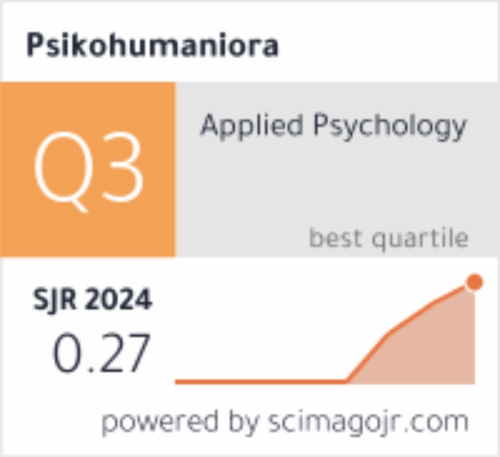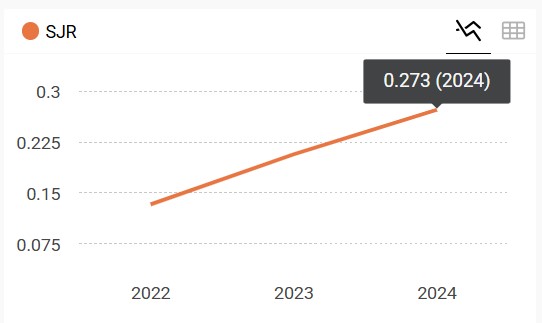Konseling Kelompok Active Music Therapy Berbasis Cognitive Behavior Therapy (CBT) untuk Meningkatkan Self-Efficacy Mahasiswa Millennials
DOI:
https://doi.org/10.21580/pjpp.v3i1.2508Keywords:
group counseling, active music therapy, cognitive behavior therapy (CBT), self-efficacyAbstract
Abstract: This research is a new breakthrough in Indonesia, which integrates the approach of Cognitive Behavior Therapy (CBT) - as a conventional counseling approach with music therapy as expressive techniques in counseling. The aim of this study is to determine the effectiveness of group counseling service implementation of CBT with active music therapy technique to improving self-efficacy of millennials students. This study used quasi-experimental design (pretest, posttest, and follow-up). Group counseling was conducted for 5 meetings (each meeting was 100 minutes), and follow-up was performed after 2 weeks of treatment. Subject selection using purposive sampling technique that is based on inclusion criteria and level of self-efficacy obtained from self-efficacy scale. The results of this research showed that group counseling of CBT with active music therapy technique was significantly effective in improving self-efficacy of millennials students at pretest vs. posttest, pretest vs. follow-up, and posttest vs. follow-up.
Abstrak: Penelitian ini merupakan terobosan baru di Indonesia yang mengintegrasikan pendekatan Cognitive Behavior Therapy (CBT) - sebagai pendekatan konseling konvensional dengan music therapy sebagai expressive techniques in counseling. Tujuan penelitian ini ialah untuk mengetahui efektivitas konseling kelompok CBT dengan teknik active music therapy untuk meningkatkan self-efficacy mahasiswa millennials penyusun skripsi. Penelitian ini menggunakan desain quasi-eksperimental (pretest, posttest, dan follow-up). Konseling kelompok dilaksanakan selama 5 pertemuan (tiap pertemuan 100 menit), dan follow-up dilakukan setelah 2 minggu diberikan treatment. Pemilihan subjek menggunakan teknik purposive sampling didasarkan pada kriteria inklusi dan tingkat self-efficacy yang diperoleh dari self-efficacy scale. Hasil penelitian menunjukkan bahwa konseling kelompok pendekatan CBT dengan teknik active music therapy secara signifikan efektif untuk meningkatkan self-efficacy mahasiswa millennials pada saat pretest vs. posttest, pretest vs. follow-up, dan posttest vs. follow-up.
Downloads
References
Abrams, B. (2010). Evidence-based music therapy practice: an integral understanding. Journal of Music Therapy, 47(4), 351–379.
Atiwannapat, P., Thaipisuttikul, P., Poopityastaporn, P., & Katekaew, W. (2016). Active versus receptive group music therapy for major depressive disorder-A pilot study. Complementary Therapies in Medicine, 26, 141–145. https://doi.org/10.1016/ j.ctim.2016.03.015
Baker, F. A., Gleadhill, L. M., & Dingle, G. A. (2007). Music therapy and emotional exploration: Exposing substance abuse clients to the experiences of non-drug-induced emotions. The Arts in Psychotherapy, 34(4), 321–330. https://doi.org/ 10.1016/j.aip.2007.04.005
Bandura, A. (1997). Self-efficacy: The exercise of control. New York: WH. Freeman.
Bastemur, S., Dursun-Bilgin, M., Yildiz, Y., & Ucar, S. (2016). Alternative therapies: New approaches in counseling. Procedia - Social and Behavioral Sciences, 217, 1157–1166. https://doi.org/10.1016/j.sbspro.2016.02.135
Bibb, J., Castle, D., & Newton, R. (2015). The role of music therapy in reducing post meal related anxiety for patients with anorexia nervosa. Journal of Eating Disorders, 3, 50.
Brabender, V., & Fallon, A. (2009). Group development in practice: guidance for clinicians and researchers on stages and dynamics of change. Washington DC.: American Psychological Association.
Bradley, L. J., Whiting, P., Hendricks, B., Parr, G., & Jr., E. G. J. (2008). The Use of Expressive techniques in counseling. Journal of Creativity in Mental Health, 3(1), 44–59. https://doi.org/10.1080/15401380802023605
Capuzzi, D., & Gross, D. R. (2011). Counseling and psychotherapy: Theories and intervention (5th ed.). New Jersey: Merril Prentice Hall.
Chen, X., Leith, H., Aarø, L. E., Manger, T., & Gold, C. (2016). Music therapy for improving mental health in offenders: protocol for a systematic review and meta-analysis. Journal of Experimental Criminology, 12(2), 209–228. Retrieved from https://arxiv.org/ftp/arxiv/papers/1503/1503.06524.pdf
Çiftçi, H., & Öztunç, G. (2015). The Effect of music on comfort, anxiety and pain in the intensive care unit: A case in Turkey. International Journal of Caring Sciences, 8(3), 594–602.
Corey, G. (2012). Theory and practice of group counseling (8th ed.). Belmon, CA: Brooks/Cole, Cengage Learning. https://doi.org/10.1016/B978-012673031-9/50018-6
Degges-White, S., & Davis, N. L. (2011). Integrating the expressive arts into counseling practice, second edition theory-based interventions. New York: Springer Publishing Company.
Djohan. (2006). Terapi musik teori dan aplikasi. Yogyakarta: Galang Press.
Djohan. (2010). Respon emosi musikal. Bandung: Lubuk Agung.
Fredenburg, H. A., & Silverman, M. J. (2014). Psychotherapy effects of cognitive-behavioral music therapy on fatigue in patients in a blood and marrow transplantation unit: A mixed-method pilot study. The Arts in Psychotherapy, 41(5), 433–444.
Gallego, M. G., & García, J. G. (2017). Music therapy and Alzheimer’s disease: Cognitive, psychological, and behavioural effects. Neurología, 32(5), 300–308. https://doi.org/ 10.1016/j.nrleng.2015.12.001
Ghasemzadeh, A., & Maryam, S. (2011). Effects of group “systematic motivational counseling” (SMC) on university student’s academic achievement and test anxiety. Procedia - Social and Behavioral Sciences, 30, 2482–2486. https://doi.org/10.1016/j.sbspro.2011.10.484
Gibson, R. L., & Mitchell, M. H. (2011). Bimbingan dan Konseling (7th ed.). Yogyakarta: Pustaka Pelajar.
Giovagnoli, A. R., Oliveri, S., Schifano, L., & Raglio, A. (2014). Active music therapy improves cognition and behaviour in chronic vascular encephalopathy: a case report. Complementary Therapies in Medicine, 22(1), 57–62. https://doi.org/10.1016/ j.ctim.2013.11.001
Gladding, S. T. (2016). The creative arts in counseling. (N. Driver, Ed.) (5th ed.). Alexandria, VA: American Counseling Association.
Gladding, S. T., Newsome, D., Binkley, E., & Henderson, D. A. (2008). The Lyrics of hurting and healing: Finding words that are revealing. Journal of Creativity in Mental Health, 3(3), 212–219. https://doi.org/10.1080/15401380802385210
Gutiérrez, E. O. F., & Camarena, V. A. T. (2015). Music therapy in generalized anxiety disorder. The Arts in Psychotherapy, 44, 19–24. https://doi.org/10.1016/j.aip.2015.02.003
Hendricks, K. S., Smith, T. D., & Legutki, A. R. (2016). Competitive comparison in music: influences upon self-efficacy beliefs by gender. Gender and Education, 28(7), 918–934. https://doi.org/10.1080/09540253.2015.1107032
Ilie, G. (2013). Effects of individual music playing and music listening on acute-stress recovery. Canadian Journal of Music Therapy, 19(1), 23–46.
Laura, D., Sylvie, J., & Aurore, S. (2015). The effects of music therapy on anxiety and depression. Ann Depress Anxiety, 2(4), 1057.
Li, H.-C., Wang, H.-H., Chou, F.-H., & Chen, K.-M. (2015). The effect of music therapy on cognitive functioning among older adults: a systematic review and meta-analysis. Journal of the American Medical Directors Association, 16(1), 71–77. https://doi.org/10.1016/j.jamda.2014.10.004
Liebmann, M. (2004). Art Therapy for Groups: A handbook of themes and exercises (2nd ed.). Hove & New York: Brunner-Routledge. https://doi.org/10.4324/9780203324219
Lilley, J. L., Oberle, C. D., & Thompson, J. G. (2014). Effects of music and grade consequences on test anxiety and performance. Psychomusicology: Music, Mind, and Brain, 24(2), 184–190. https://doi.org/10.1037/pmu0000038
Limb, C. J. (2006). Structural and functional neural correlates of music perception. The Anatomical Record Part A: Discoveries in Molecular, Cellular, and Evolutionary Biology, 288A(4), 435–446. https://doi.org/10.1002/ar.a.20316
Machtinger, E. L., Lavin, S. M., Hilliard, S., Jones, R., Haberer, J. E., Capito, K., & Dawson-Rose, C. (2015). An expressive therapy group disclosure intervention for women living with HIV improves social support, self-efficacy, and the safety and quality of relationships: a qualitative analysis. The Journal of the Association of Nurses in AIDS Care : JANAC, 26(2), 187–198. https://doi.org/10.1016/j.jana.2014.05.001
Mamahit, H. C., & Situmorang, D. D. B. (2016). Hubungan Self-Determination dan Motivasi Berprestasi dengan Kemampuan Pengambilan Keputusan Siswa SMA. Jurnal Psikologi Psibernetika, 9(2), 78–92.
Menzies, V., Taylor, A. G., & Bourguignon, C. (2006). Effects of Guided Imagery on Outcomes of Pain, Functional Status, and Self-Efficacy in Persons Diagnosed with Fibromyalgia. Journal of Alternative and Complementary Medicine, 12(1), 23-30. https://doi.org/10.1089/acm.2006.12.23
Mucci, K. L., & Mucci, R. J. (2000). The Healing sound of music. Vermont: Findhorn Press.
Ottens, A. J. (1991). Coping with academic anxiety. New York: The Rosen Publishing Group.
Purwanto, E. (2012). Pengelolaan kecemasan di kelas. In J. E. Prawitasari (Ed.), Psikologi terapan: Melintas batas disiplin ilmu (pp. 74–86). Jakarta: Erlangga.
Rogers, D. R. B., Ei, S., Rogers, K. R., & Cross, C. L. (2007). Evaluation of a multi-component approach to cognitive-behavioral therapy (CBT) using guided visualizations, cranial electrotherapy stimulation, and vibroacoustic sound. Complementary Therapies in Clinical Practice, 13(2), 95–101. https://doi.org/10.1016/j.ctcp.2006.10.002
Rosanty, R. (2014). Pengaruh musik Mozart dalam mengurangi stres pada mahasiswa yang sedang skripsi. Journal of Educational, Health and Community Psychology, 3(2), 71–78.
Schunk, D. H., Pintrich, P. R., & Meece, J. L. (2014). Motivation in education: Theory, research, and applications (3rd ed.). New Jersey: Pearson Education, Inc.
Sharf, R. S. (2012). Theories of Psychotherapy and Counseling: Concepts and Cases. Belmon, CA: Brooks/Cole, Cengage Learning. https://doi.org/10.1007/s13398-014-0173-7.2
Silverman, M. J. (2012). Effects of group songwriting on motivation and readiness for treatment on patients in detoxification: a randomized wait-list effectiveness study. Journal of Music Therapy, 49(4), 414–429.
Silverman, M. J. (2014). Effects of music therapy on drug avoidance self-efficacy in patients on a detoxification unit: A three-group randomized effectiveness study. Journal of Addictions Nursing, 25(4), 172–181. https://doi.org/10.1097/JAN.0000000000000047
Situmorang, D. D. B. (2005). Peranan musik bagi perkembangan panggilan para seminaris di Seminari Menengah Stella Maris Bogor (Unpublished seminarian’s thesis). Seminari Menengah Stella Maris Bogor, Indonesia.
Situmorang, D. D. B. (2007). Refleksi akhir selama menapaki hidup panggilan di Seminari Menengah Stella Maris (Unpublished seminarian’s thesis). Seminari Menengah Stella Maris Bogor, Indonesia.
Situmorang, D. D. B. (2016). Hubungan antara potensi kreativitas dan motivasi berprestasi mahasiswa program studi bimbingan dan konseling angkatan 2010 FKIP Unika Atma Jaya. JBKI (Jurnal Bimbingan Konseling Indonesia), 1(1), 6–9. https://doi.org/ 10.26737/jbki.v1i1.97
Situmorang, D. D. B. (2017a). Efektivitas pemberian layanan intervensi music therapy untuk mereduksi academic anxiety mahasiswa terhadap skripsi. JBKI (Jurnal Bimbingan Konseling Indonesia), 2(1), 4. https://doi.org/10.26737/jbki.v2i1.242
Situmorang, D. D. B. (2017b). Mahasiswa mengalami academic anxiety terhadap skripsi? Berikan konseling Cognitive Behavior Therapy dengan musik. Jurnal Bimbingan dan Konseling Ar-Rahman, 3, 31–42.
Situmorang, D. D. B. (2018). Keefektifan konseling kelompok cognitive behavior therapy (CBT) dengan teknik passive dan active music therapy terhadap academic anxiety dan self-efficacy. Semarang: Program Pascasarjana Universitas Negeri Semarang.
Skudrzyk, B., Zera, D. A., McMahon, G., Schmidt, R., Boyne, J., & Spannaus, R. L. (2014). Learning to relate: Interweaving creative approaches in group counseling with adolescents. Journal of Creativity in Mental Health, 4(3), 249–261.
Vargas, M. E. R. (2015). Music as a resource to develop cognition. Procedia - Social and Behavioral Sciences, 174, 2989–2994.
Vianna, M. N. S., Barbosa, A. P., Carvalhaes, A. S., & Cunha, A. J. L. A. (2011). Music therapy may increase breastfeeding rates among mothers of premature newborns: a randomized controlled trial. Jornal de Pediatria, 87(3), 206–212. https://doi.org/ 10.2223/JPED.2086
White, J. R., & Freeman, A. S. (2000). Cognitive-behavioral group therapy: For specific problems and populations. Washington DC.: American Psychological Association.
Wibowo, M. E. (2005). Konseling kelompok perkembangan. Semarang: Unnes Press.
Wigram, T., Pedersen, I. N., & Bonde, L. O. (2002). A Comprehensive guide to music therapy: theory, clinical practice, research and training. London: Jessica Kingsley Publisher, Ltd.
Zarate, R. (2016). Clinical improvisation and its effect on anxiety: A multiple single subject design. Arts in Psychotherapy, 48, 46–53. https://doi.org/10.1016/j.aip.2015.11.005
Zarei, E., Fini, A. A. S., & Fini, H. K. (2010). A comparison of effect of group counselling methods, behavioural, cognitive and cognitive- behavioural to reduce students test anxiety in the University of Hormozgan. Procedia - Social and Behavioral Sciences, 5, 2256–2261. https://doi.org/10.1016/j.sbspro.2010.07.445
Zhang, Y., Cai, J., An, L., Hui, F., Ren, T., Ma, H., & Zhao, Q. (2017). Does music therapy enhance behavioral and cognitive function in elderly dementia patients? A systematic review and meta-analysis. Ageing Research Reviews, 35, 1–11. https://doi.org/10.1016/j.arr.2016.12.003
Downloads
Additional Files
Published
How to Cite
Issue
Section
License
The copyright of the accepted article shall be assigned to the publisher of the journal. The intended copyright includes the right to publish the article in various forms (including reprints). The journal maintains the publishing rights to published articles.
In line with the license, authors and any users (readers and other researchers) are allowed to share and adapt the material only for non-commercial purposes. In addition, the material must be given appropriate credit, provided with a link to the license, and indicated if changes were made. If authors remix, transform, or build upon the material, authors must distribute their contributions under the same license as the original.




